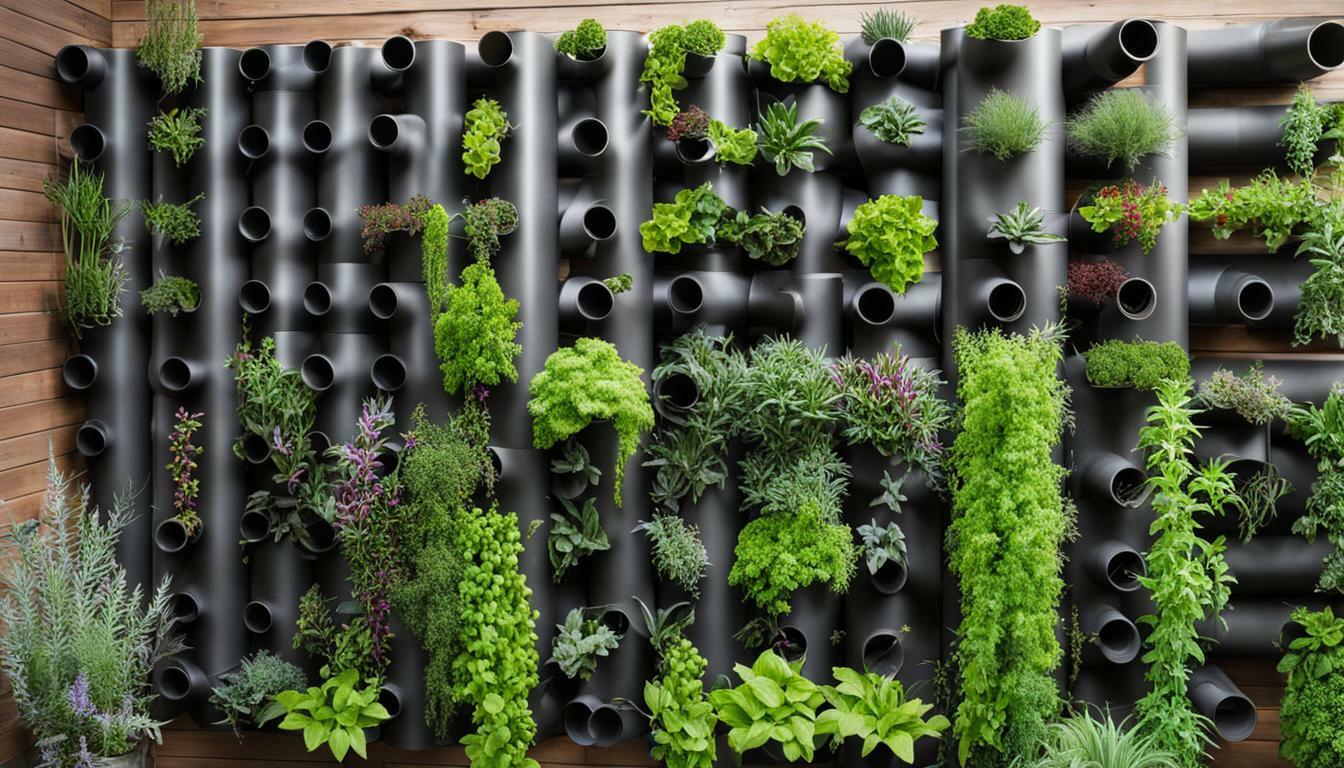Welcome to the world of vertical PVC pipe gardens, where creativity and innovation meet to transform your space into a thriving green haven. Vertical PVC pipe gardens offer a unique and innovative solution for maximizing your gardening potential, especially if you have limited space. By utilizing vertical space, you can create a stunning display of plants that not only beautify your surroundings but also provide numerous benefits. Whether you are an urban dweller looking to optimize your space or a gardening enthusiast seeking a new challenge, mastering the art of vertical PVC pipe garden creation is an exciting endeavor.
Key Takeaways:
- Vertical PVC pipe gardens are a creative and innovative solution for maximizing gardening potential.
- They are ideal for urban dwellers with limited space and offer numerous benefits, including space optimization and visual appeal.
- PVC pipe is a versatile material that is durable and easy to assemble, making it perfect for DIY gardening projects.
- Building a vertical PVC pipe garden requires specific materials and tools, and following a step-by-step guide can help ensure successful creation.
- Choosing the right plants and properly maintaining the garden are crucial for its longevity and health.
- Vertical PVC pipe gardens offer endless design possibilities, allowing you to create unique and visually stunning displays.
- Success stories and testimonials from individuals who have created their own vertical PVC pipe gardens showcase the positive impact they can have on living spaces.
- Challenges in vertical PVC pipe garden creation can be overcome with troubleshooting tips and solutions.
- Mastering the art of vertical PVC pipe garden creation opens up a world of possibilities and encourages creativity in the realm of gardening.
Understanding the Benefits of Vertical Gardening
Vertical gardening offers a myriad of benefits, with its ability to optimize space being one of its most valuable advantages for urban dwellers. With limited outdoor areas, many city dwellers struggle to find room for traditional gardens. However, vertical gardening provides a creative solution, allowing them to utilize vertical spaces such as walls, balconies, and rooftops.
One of the key benefits of vertical gardening is space optimization. By growing plants vertically, gardeners can make the most of limited space, turning bare walls into lush green spaces. This is especially important for urban environments, where outdoor areas are at a premium. Vertical gardens not only beautify the surroundings but also maximize the use of available space, allowing individuals to enjoy the benefits of gardening even in small apartments or homes.
Additionally, vertical gardening promotes better air quality and reduces heat absorption in urban areas. Plants act as natural air purifiers, filtering out pollutants and releasing oxygen, thus improving the overall air quality. They also provide shade and insulation, reducing the impact of heat islands in cities. Vertical gardens help to create a cooler microclimate by absorbing sunlight and reducing the temperature of the surrounding area.
Furthermore, vertical gardening offers a practical solution for growing fresh produce in urban environments. By growing vegetables and herbs vertically, individuals can have access to homegrown, organic food without the need for a large garden space. This not only promotes sustainability but also encourages healthy eating habits.
| Benefits of Vertical Gardening |
|---|
| Optimizes limited space |
| Improves air quality and reduces heat absorption |
| Provides a practical solution for growing fresh produce |
Vertical gardening offers a creative solution for urban dwellers to maximize space, improve air quality, and have access to homegrown produce.
Exploring the Versatility of PVC Pipe
PVC pipe has emerged as a game-changer in the world of DIY projects, with its unmatched versatility and ease of assembly. This affordable and durable material has proven to be a valuable asset for creative individuals looking to explore various projects. From simple structures to complex designs, PVC pipe offers endless possibilities for those seeking a customizable and unique solution.
One of the key advantages of PVC pipe is its adaptability to different shapes and sizes. With a wide range of diameters available, you can easily find the perfect fit for your specific project. Whether you’re building a greenhouse, a shelving unit, or a vertical garden, PVC pipe can be easily manipulated and connected to create the desired structure. Its lightweight nature also makes it easy to transport and work with, allowing for hassle-free assembly.
In addition to its versatility, PVC pipe is also known for its durability. It is resistant to corrosion, weathering, and impact, making it suitable for both indoor and outdoor applications. This means that your DIY project will stand the test of time, providing you with long-lasting functionality and aesthetic appeal. Furthermore, PVC pipe is low maintenance, requiring minimal upkeep once your project is complete.
DIY Project Inspiration with PVC Pipe
Looking for some inspiration for your next DIY project with PVC pipe? Here are a few ideas to get you started:
- Create a plant stand or trellis for your garden
- Build a custom shoe rack or storage organizer
- Construct a playhouse or fort for your children
- Design a unique lighting fixture or chandelier
Remember, the possibilities are endless when it comes to PVC pipe projects. Let your imagination run wild and explore the many ways this versatile material can enhance your DIY endeavors.
| Pros of PVC Pipe | Cons of PVC Pipe |
|---|---|
| Easy to cut and assemble | Not suitable for high-pressure applications |
| Lightweight and portable | May release toxic fumes when heated |
| Durable and weather-resistant | Not as aesthetically pleasing as other materials |
| Affordable and readily available | Can become brittle over time |
As with any DIY project, it’s important to take safety precautions and follow proper guidelines when working with PVC pipe. Always wear protective gear, such as gloves and safety glasses, and use the appropriate tools for cutting and assembling. Additionally, be mindful of the environment and dispose of PVC pipe responsibly when it is no longer needed.
Materials and Tools for Vertical PVC Pipe Garden Creation
Before embarking on your vertical PVC pipe garden creation journey, it’s important to gather the necessary materials and tools to ensure a smooth and successful project. The following list outlines the essential items you’ll need:- PVC pipe – 6-to-8-inch diameter by 4 ft. long
- PVC pipe – 1½-to-2-inch diameter by 4 ft. long
- Potting soil
- 16 Pieces Recycled cardboard, roughly 2-inch square
- 17 Seedlings of lettuce and mixed greens
- Cordless or electric drill
- 1-1/2 inch Hole saw for drill
- ¼ inch Drill bit
- Pencil
- Tape measure
Step-by-Step Guide to Building a Vertical PVC Pipe Garden
To build your vertical PVC pipe garden, follow these step-by-step instructions:- Mark four evenly spaced lines vertically down the large pipe. These lines will serve as guides for the holes you’ll drill.
- Measure 12 inches from one end and mark a line around the circumference of the pipe.
- Using the hole saw, drill one hole where a vertical line intersects with a horizontal line. Drill a second hole directly opposite, at the intersection of another vertical and horizontal line. Repeat this process to create two lines of four drilled holes.
- Drill three more holes along each vertical line, offsetting each new hole diagonally from those adjacent to it.
- Drill about 30 randomly-placed quarter-inch holes in the 2-inch PVC pipe.
- Place the smaller PVC pipe inside the larger PVC pipe, ensuring the top of the inner pipe is slightly higher than the outer pipe. Fill the larger pipe with potting soil up to the bottom of the lowest holes, keeping the inner pipe centered.
- Fold a piece of cardboard into a V shape and set it inside a hole. Slide a seedling into each hole using the cardboard as a funnel, then pull and bend the cardboard into place between the seedling and the hole. Repeat this process for each hole.
- Water the tower slowly from the top, as well as into the 2-inch pipe.
| PVC Pipe Diameter | Quantity | Length |
|---|---|---|
| 6-to-8 inch | 1 | 4 ft. |
| 1½-to-2 inch | 1 | 4 ft. |
Step-by-Step Guide to Building a Vertical PVC Pipe Garden
Follow these step-by-step instructions to build your own vertical PVC pipe garden and turn your space into a thriving oasis of greenery.
Materials:
- 6-to-8-inch diameter PVC pipe, 4 ft. long
- 1½-to-2-inch diameter PVC pipe, 4 ft. long
Tools:
- Cordless or electric drill
- 1-1/2 inch hole saw for drill
- ¼ inch drill bit
- Pencil
- Tape measure
Instructions:
- Mark four evenly spaced lines vertically down the large PVC pipe. These will serve as guides for the holes you’ll drill.
- Measure 12 inches from one end and mark a line around the circumference of the pipe. For reference, mark this end of the pipe “DOWN” so you’ll remember that this end should go down into the soil when assembling your vertical garden tower.
- Using the hole saw, drill one hole where a vertical line intersects with a horizontal line. Now drill a second hole directly opposite, again at the intersection of a vertical and horizontal line.
- Drill three more holes along the same vertical lines, leaving about 10 inches between holes. You now have two lines of four drilled holes.
- Drill three holes on each of the remaining vertical lines, offsetting each new hole so that it’s placed diagonally from those adjacent to it, making an alternating pattern.
- To use in the garden, use a shovel to dig a 10-inch deep hole in the ground and bury the bottom end of the pipe almost to the first hole. To use on a patio or balcony, drill several holes in the bottom of a 5-gallon bucket or large planter and fill halfway with gravel. Place the pipe on top of the gravel and add soil around the pipe, up to the top of the container.
- Drill about 30 randomly-placed quarter-inch holes in the 2-inch PVC pipe.
- Place the small PVC pipe inside the larger PVC pipe so that the top of the inner pipe is slightly higher than the outer pipe. Once established, filling this inner pipe with water aids in getting moisture to the roots.
- Fill the large pipe with potting soil up to the bottom of the lowest holes, keeping the inner pipe centered.
- Fold a piece of cardboard into a V-shape and set it inside the hole. Slide a seedling into each of the lowest holes, using the cardboard as a funnel. Gently push the piece of cardboard into the hole, being careful not to damage the seedling.
- Add more soil to reach the next set of holes and repeat the previous step. Continue to fill and plant each hole until the entire vertical pipe garden is complete.
- Water the tower slowly from the top as well as into the 2-inch pipe.
- Harvest leafy greens as they grow and enjoy the beauty and functionality of your vertical PVC pipe garden!
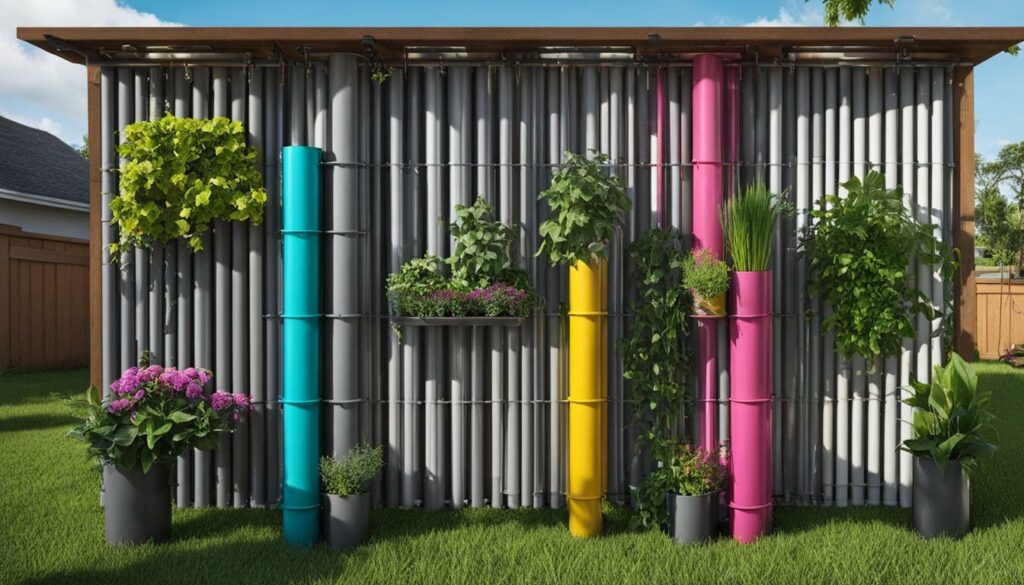
Creating a vertical PVC pipe garden is a practical and creative solution for gardeners with limited space. By following these step-by-step instructions, you can build your own vertical garden tower and maximize your gardening potential. From selecting the materials and tools needed to planting and maintaining your garden, this guide provides all the information you need to create a flourishing vertical PVC pipe garden.
Choosing the Right Plants for Your Vertical PVC Pipe Garden
Selecting the perfect plants for your vertical PVC pipe garden is key to ensuring their successful growth and creating a visually appealing display. With limited space and unique growing conditions, it’s important to choose plants that are well-suited for vertical gardening. Here are some factors to consider when selecting plants for your vertical PVC pipe garden:
- Sunlight: Evaluate the amount of sunlight your vertical garden receives throughout the day. Some plants thrive in full sun, while others prefer partial shade. Consider the orientation of your garden and choose plants that match the sunlight requirements.
- Space Constraints: Vertical gardens have limited space, so it’s essential to select plants that don’t require extensive root systems or take up too much vertical space. Look for compact varieties or plants that can be trained to grow vertically.
- Watering Needs: Vertical gardens can have different watering requirements compared to traditional gardens. Some plants may need more frequent watering to ensure proper hydration, while others are more drought-tolerant. Consider your watering routine and choose plants that fit your schedule.
- Climate Compatibility: Take into account your local climate and choose plants that are well-suited for your region. Some plants thrive in cooler climates, while others are more tolerant of heat and humidity.
By considering these factors, you can select plants that will not only thrive in your vertical PVC pipe garden but also create a visually stunning display. Mix and match plants with different heights, textures, and colors to add interest and variety to your garden. Here are a few plant suggestions that work well in vertical PVC pipe gardens:
| Plant Name | Sunlight Requirement | Spacing | Watering Needs | Climate Compatibility |
|---|---|---|---|---|
| Herbs (such as basil, mint, and oregano) | Full sun to partial shade | 1 plant per hole | Regular watering | Varies by herb |
| Succulents (such as sedum and echeveria) | Full sun to partial shade | 1 plant per hole | Low water requirements | Drought-tolerant |
| Vining plants (such as pothos and philodendron) | Partial shade to shade | 1-2 plants per hole | Regular watering | Varies by plant |
| Flowering annuals (such as petunias and begonias) | Full sun to partial shade | 1 plant per hole | Regular watering | Varies by plant |
Remember to care for your plants by providing proper water and nutrients, as well as monitoring for pests and diseases. Regularly prune and trim your plants to maintain their shape and prevent overcrowding in your vertical garden. With careful plant selection and maintenance, your vertical PVC pipe garden will flourish and become a stunning focal point in your space.
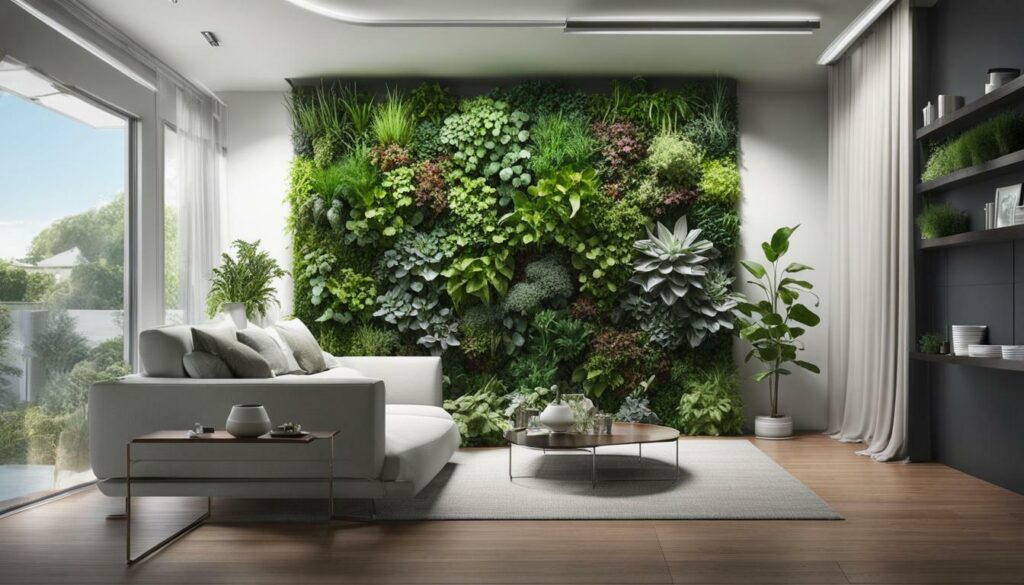
Maintaining and Caring for Your Vertical PVC Pipe Garden
Keeping your vertical PVC pipe garden in top shape requires regular maintenance and care to ensure the health and vitality of your plants. By following a few simple guidelines, you can ensure that your garden thrives and continues to be a beautiful and functional addition to your space.
Watering
Watering is a crucial aspect of maintaining your vertical PVC pipe garden. Because the plants are arranged vertically, proper water distribution is essential to ensure that all plants receive adequate moisture. Consider installing an irrigation system with drippers or emitters that provide a slow, consistent flow of water to each plant. This will help prevent overwatering or underwatering and promote healthy growth.
Regularly monitor the moisture levels in the soil and adjust your watering schedule accordingly. Be mindful of weather conditions and seasonal changes, as these can affect the water needs of your plants. It’s important to strike a balance between providing enough water for growth and avoiding waterlogged soil that can lead to root rot.
Fertilizing
Proper fertilization is essential for maintaining the nutrient levels necessary for the growth and development of your plants. Use a balanced, water-soluble fertilizer and follow the manufacturer’s instructions for application rates. Be cautious not to over-fertilize, as this can cause nutrient burn and harm the plants.
Consider incorporating organic fertilizers or compost into your routine to provide additional nutrients and improve soil fertility. This will help promote healthy plant growth and enhance the overall vitality of your vertical PVC pipe garden.
Pest and Disease Control
Regularly inspect your plants for signs of pests or diseases. Common pests that may affect your vertical PVC pipe garden include aphids, spider mites, and whiteflies. If you notice any signs of infestation, promptly treat the affected plants with organic or chemical insecticides, following the instructions provided.
Preventative measures such as regular pruning, removing dead or diseased plant material, and maintaining good airflow around your plants can help minimize the risk of pests and diseases. Additionally, practicing proper sanitation by cleaning your tools and equipment regularly can help prevent the spread of pests and diseases.
Conclusion
Maintaining and caring for your vertical PVC pipe garden is key to its long-term success and beauty. By following a regular watering schedule, providing adequate fertilization, and staying vigilant against pests and diseases, you can ensure that your garden thrives and continues to be a source of joy and inspiration.
Remember, each plant is unique and may have specific care requirements, so it’s important to research the specific needs of the plants you choose for your vertical PVC pipe garden. With proper maintenance and care, your garden will flourish, bringing life and beauty to your space.
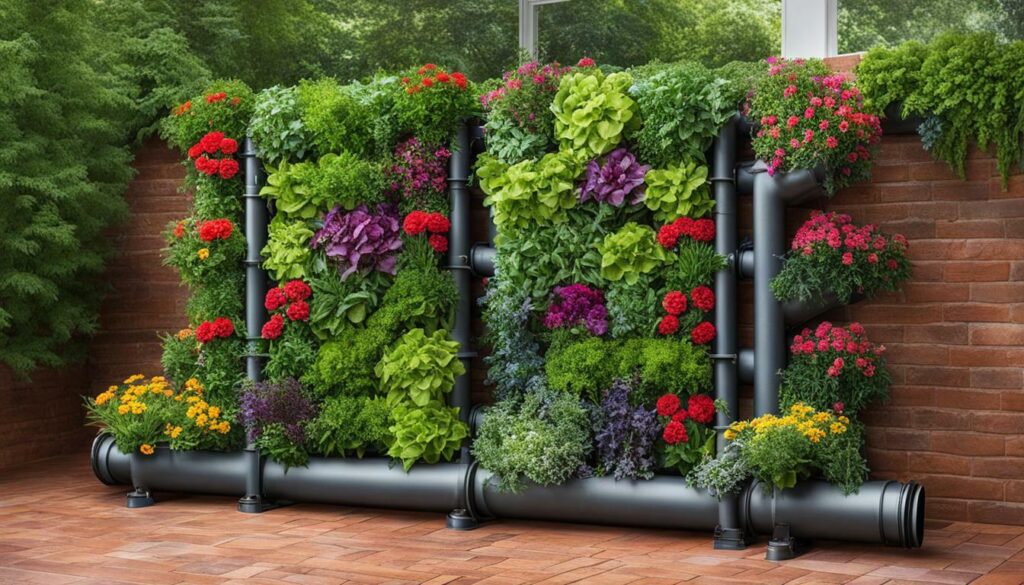
Inspiring Design Ideas for Vertical PVC Pipe Gardens
Get inspired by these design ideas and unleash your creativity to create a stunning vertical PVC pipe garden that will be the envy of all. Vertical gardens are not only space-saving solutions but also eye-catching displays that can transform any dull wall or empty space into a vibrant oasis. With the versatility of PVC pipe, you have endless possibilities to experiment with and create unique designs that suit your style and preferences.
Here are some inspiring design ideas to get you started:
- Create a cascading effect by arranging PVC pipes in a staggered pattern, with shorter ones at the top and longer ones at the bottom. This creates a visually appealing waterfall effect as plants spill over from one pipe to the next, creating a lush and vibrant display.
- Use different pipe diameters to create a multi-level garden. By varying the sizes of the pipes, you can create depth and dimension in your vertical garden. Plant taller plants in the larger pipes and smaller plants in the smaller pipes to create an interesting contrast.
- Add pops of color by painting the PVC pipes in vibrant hues. Choose colors that complement your outdoor space or go for bold and contrasting shades to make a statement. The painted pipes will not only serve as functional planters but also as decorative elements that add a touch of personality to your garden.
- Combine PVC pipes with other materials like wood or metal to create a more eclectic and unique look. Incorporate wooden shelves or metal frames into your vertical garden design to add additional layers and textures. This combination of materials adds visual interest and creates a dynamic and visually appealing display.
Remember to choose plants that thrive in vertical gardens and consider their sunlight requirements and growth habits when arranging them in the pipes. Succulents, herbs, and trailing plants are popular choices for vertical gardens due to their adaptability and low maintenance needs.
With these design ideas as inspiration, you can create a vertical PVC pipe garden that not only maximizes space but also becomes a stunning focal point in your outdoor or indoor living areas. Let your imagination run wild and create a one-of-a-kind garden that reflects your personal style and enhances the beauty of your surroundings.
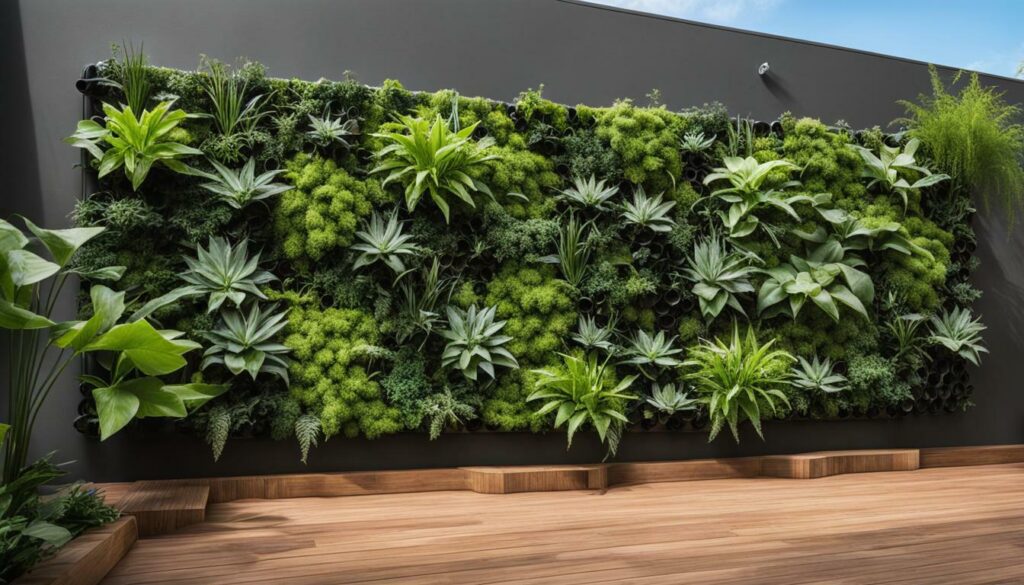
| Design Idea | Description |
|---|---|
| Cascading Effect | Create a visually appealing waterfall effect by arranging PVC pipes in a staggered pattern, allowing plants to spill over from one pipe to the next. |
| Multi-Level Garden | Vary the sizes of the PVC pipes to create depth and dimension in your vertical garden, with taller plants in larger pipes and smaller plants in smaller pipes. |
| Pops of Color | Add visual interest by painting the PVC pipes in vibrant hues, complementing your outdoor space or making a bold statement with contrasting shades. |
| Combining Materials | Incorporate other materials like wood or metal into your vertical garden design to create an eclectic and unique look with added layers and textures. |
These design ideas offer just a glimpse of the endless possibilities that exist when it comes to creating a vertical PVC pipe garden. Let your creativity take flight and design a stunning living masterpiece that will elevate the aesthetics and functionality of your outdoor or indoor space.
Showcasing Success Stories of Vertical PVC Pipe Gardens
Discover the success stories of individuals who have transformed their living spaces with vertical PVC pipe gardens and find inspiration for your own project. These innovative gardeners have mastered the art of creating vibrant and functional gardens using PVC pipes, proving that limited space is no obstacle to greenery and beauty.
One such success story comes from Jane, a city dweller with a small balcony. Frustrated with her lack of gardening space, Jane decided to try her hand at vertical gardening. She built a vertical PVC pipe garden using recycled materials and filled it with a variety of herbs and flowers. Not only did her balcony transform into a lush oasis, but Jane also discovered a newfound love for gardening and the joy of harvesting fresh herbs for her meals.
Another inspiring success story comes from Mark, who turned his drab backyard wall into a stunning vertical garden masterpiece. Using PVC pipes of different lengths and diameters, Mark created a unique and visually striking arrangement of plants and flowers. The vertical garden became a focal point of his outdoor space and received rave reviews from friends and family.
| Success Stories | Key Takeaways |
|---|---|
| Jane’s Balcony Garden | – Limited space is not a barrier to gardening – Vertical PVC pipe gardens can be created using recycled materials – Fresh herbs can be easily grown at home |
| Mark’s Backyard Masterpiece | – PVC pipes of different lengths and diameters can create a visually striking vertical garden – Vertical gardens can become focal points in outdoor spaces – Friends and family can admire and appreciate the beauty of a vertical garden |
These success stories showcase the endless possibilities of vertical PVC pipe gardens. With a little creativity and some basic materials, anyone can create their own unique garden that brings life and beauty to even the smallest of spaces. Whether you have a balcony, a backyard wall, or a limited gardening area, a vertical PVC pipe garden can transform your space and inspire others to embark on their own gardening journey.
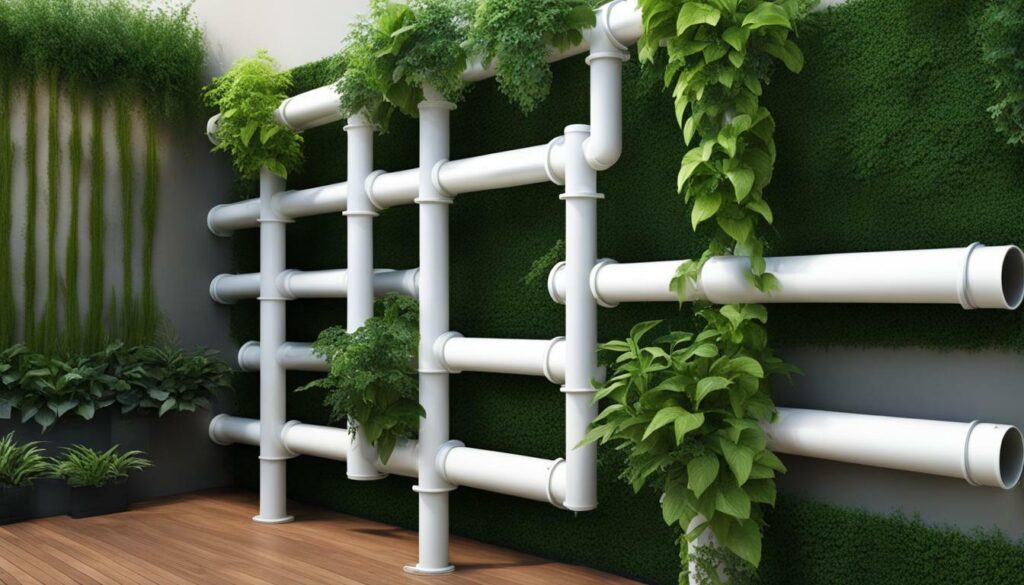
Get Started on Your Vertical PVC Pipe Garden
If you’re ready to embark on your own vertical PVC pipe garden project, here are a few key tips to keep in mind:
- Choose a suitable wall or area for your vertical garden, considering factors such as sunlight and accessibility.
- Gather the necessary materials, including PVC pipes, elbows, and fabric for the planting pockets.
- Follow a step-by-step guide to build your vertical garden structure, ensuring proper stability and support.
- Select the right plants for your vertical garden, taking into account their growth patterns and sunlight requirements.
- Care for your vertical garden by regularly watering, pruning, and checking for any signs of pests or diseases.
By following these tips and drawing inspiration from the success stories of others, you can create your own vertical PVC pipe garden and reap the rewards of a beautiful, functional, and sustainable garden space.
Overcoming Challenges in Vertical PVC Pipe Garden Creation
Building a vertical PVC pipe garden may come with its fair share of challenges, but with the right knowledge and techniques, you can overcome any hurdle that comes your way. Whether you’re a beginner or an experienced gardener, it’s important to be prepared for potential difficulties and have solutions at hand. Here are some common challenges you may encounter when creating a vertical PVC pipe garden and how to troubleshoot them:
1. Limited Space
One of the main reasons people opt for vertical gardening is to optimize space in small areas. However, limited space can present challenges in terms of plant selection and arrangement. To overcome this challenge, consider using compact and trailing plants that can grow vertically, such as herbs, lettuce, and strawberries. Additionally, plan your garden layout carefully to make the most of the available space, utilizing different levels and angles to maximize plant coverage.
2. Watering and Drainage
Proper watering and drainage are crucial for the health and success of your vertical PVC pipe garden. As gravity pulls water downwards, the lower plants may receive more water than the upper ones. To overcome this challenge, consider installing an irrigation system with drip emitters or misters to ensure even water distribution. Additionally, ensure that your PVC pipes have adequate drainage holes to prevent waterlogging, which can lead to root rot. Regularly monitor the moisture levels and adjust your watering schedule as needed.
3. Structural Stability
Ensuring the stability and durability of your vertical PVC pipe garden is essential, especially if you live in an area prone to strong winds or heavy rainfall. To overcome this challenge, reinforce your structure by securely attaching the PVC pipes to a stable support, such as a wall or fence. Consider using additional supports like brackets or wire mesh for added stability. Regularly inspect your garden for any signs of structural weakness and make necessary repairs or adjustments to maintain its integrity.
4. Plant Health and Maintenance
Vertical gardening requires careful attention to plant health and maintenance. Pests, diseases, and nutrient deficiencies can affect the growth and productivity of your plants. To overcome this challenge, regularly inspect your plants for signs of pests or diseases and take appropriate measures to control them, such as using organic insecticides or implementing biological pest control methods. Additionally, regularly fertilize your plants with a balanced fertilizer to ensure they receive the necessary nutrients for healthy growth. Prune and trim your plants as needed to maintain their shape and prevent overcrowding.
By being aware of these challenges and implementing the appropriate solutions, you can create a successful and thriving vertical PVC pipe garden. With patience, dedication, and a little bit of creativity, you can transform any space into a green oasis that adds beauty and functionality to your surroundings.
Table: Common Challenges in Vertical PVC Pipe Garden Creation
| Challenge | Troubleshooting |
|---|---|
| Limited Space | – Select compact and trailing plants – Plan layout carefully for maximum coverage |
| Watering and Drainage | – Install an irrigation system with drip emitters or misters – Ensure proper drainage holes in PVC pipes |
| Structural Stability | – Securely attach PVC pipes to a stable support – Reinforce with brackets or wire mesh if needed |
| Plant Health and Maintenance | – Regularly inspect plants for pests and diseases – Use organic insecticides and implement biological pest control – Fertilize plants with balanced fertilizer – Prune and trim plants as needed |
Conclusion
In conclusion, a vertical PVC pipe garden is a versatile and innovative way to bring the beauty of nature into your space while optimizing limited areas. Whether you have a small backyard, a balcony, or even just a blank wall, a vertical PVC pipe garden allows you to create a stunning display of plants and flowers that can transform your surroundings into a vibrant oasis.
With its easy assembly, durability, and flexibility, PVC pipe provides the perfect material for creating DIY projects such as vertical gardens. By utilizing unused space and going vertical, you can maximize your gardening efforts and create a visually striking arrangement that is both functional and aesthetically pleasing.
From the benefits of vertical gardening to the step-by-step guide on building your own vertical PVC pipe garden, this article has provided you with the knowledge and inspiration you need to embark on your creative gardening journey. With careful plant selection, proper maintenance, and a touch of design creativity, you can enjoy the beauty and rewards of a thriving vertical garden right in your own home.
What Are the Basics of Creating a Vertical PVC Pipe Garden?
Creating a PVC pipe vertical garden is a simple and cost-effective way to grow plants in small spaces. Start by cutting the PVC pipe into sections, then attach them to a frame. Add a growing medium and your choice of plants. Water regularly and enjoy your new space-saving garden.
FAQ
Q: Can I use PVC pipe to create a vertical garden?
A: Yes, PVC pipe is a versatile material that can be used to create a vertical garden. It is durable, easy to assemble, and can be customized to fit your space.
Q: What are the benefits of vertical gardening?
A: Vertical gardening allows you to optimize your space by growing plants vertically, making it ideal for small gardens or urban areas with limited space. It also adds a unique visual element to your garden and can help improve air quality.
Q: What materials and tools do I need to create a vertical PVC pipe garden?
A: You will need PVC pipe in various diameters, potting soil, cardboard, seedlings, a cordless or electric drill, a hole saw, a drill bit, a pencil, and a tape measure.
Q: How do I build a vertical PVC pipe garden?
A: To build a vertical PVC pipe garden, start by marking evenly spaced lines on the large pipe. Drill holes where the lines intersect, leaving about 10 inches between each hole. Attach a smaller PVC pipe inside the larger one and fill with potting soil. Use cardboard squares to hold the soil in place while planting seedlings.
Q: What type of plants can I grow in a vertical PVC pipe garden?
A: Small plants like lettuce, bok choy, kale, and herbs are ideal for a vertical PVC pipe garden. You can also grow strawberries to keep them off the ground and out of reach of pests.
Q: How do I maintain and care for a vertical PVC pipe garden?
A: To maintain a vertical PVC pipe garden, regularly water the plants, monitor for pests, and provide adequate sunlight. Prune and harvest plants as needed and keep the PVC pipe clean and free of debris.
Q: Can I customize the design of my vertical PVC pipe garden?
A: Yes, the design options for a vertical PVC pipe garden are nearly endless. You can experiment with different pipe diameters, heights, and arrangements to create a unique and visually appealing garden.
Q: What are some inspiring design ideas for vertical PVC pipe gardens?
A: Some inspiring design ideas for vertical PVC pipe gardens include creating elaborate geometric patterns, using different colored pipes, and combining different plant varieties for a vibrant display.
Q: How can I overcome challenges in vertical PVC pipe garden creation?
A: Common challenges in vertical PVC pipe garden creation include ensuring proper drainage, preventing soil erosion, and maintaining adequate water and nutrient levels. By following proper planting and maintenance techniques, these challenges can be successfully overcome.
Q: Can you share some success stories of vertical PVC pipe gardens?
A: Many individuals have successfully created their own vertical PVC pipe gardens and have experienced the benefits of this innovative gardening technique. These success stories showcase the beauty and functionality of vertical PVC pipe gardens.
Q: What is the conclusion of this article?
A: Vertical PVC pipe gardens offer a creative and efficient way to maximize your gardening space. With proper planning, design, and maintenance, you can create a stunning vertical garden that adds beauty and functionality to your home or outdoor space.

